
I’d estimate that one out of ten new homesteading projects succeeds. Which is why I’m especially happy that the long process of drying persimmons the Japanese way (hoshigaki) has been a big success. The white powder that looks like mold is sugar in the fruit that has risen to the surface. The result is, incidentally, very different from drying persimmons in a dehydrator (which also tastes good but has a much firmer texture–hoshigaki has the texture of a gummy bear).
It took about a month. One observation is that the persimmons that got the most sun also developed the most “frosting”.
Hoshigaki sells for upwards of $35 a pound–I just saw some at a Japanese market and they did not look as good as the ones I made. This is definitely a project I’ll be repeating next year. They would make a great gift along with some green tea.
You can read our blog post on how to make Japanese dried persimmons (hoshigaki) here.
Note from Kelly:
I thought we should say something about flavor here. They are not as sweet as I thought they might be. Which is not to say they’re not sweet, they’re just not super-sweet. They have a sort of meaty richness to them–in a strange way, they remind me a little of Fig Newtons, minus that seedy texture. The sugar dusting (sucrose powder?) is very delicate and a bit floral. I can only taste it if I touch my tongue to it.
These are traditionally served with green tea, and I have to say that tradition nailed it–that’s a perfect combo of flavors. Other than eating them ceremonially with tea, they are a very nice dried fruit and can be used any way you usually use dried fruit.
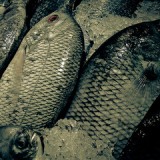
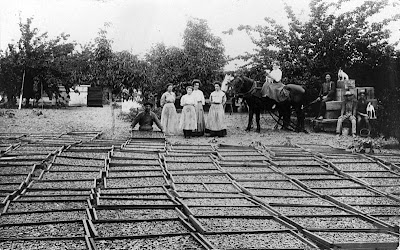
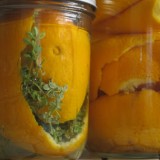
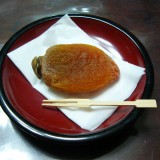
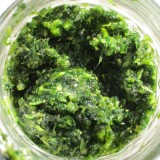
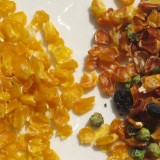
That is awesome! I have been researching growing persimmons up here in MN, but can probably only grow the varieties that are native to America, not the sweeter Asian varieties. Oh well!
Persimmons native to the South are terribly sweet. I am just wondering how sweet Asian persimmons can be.
@Parsimony: Asian persimmons are sweet. I don’t know how this would work if the fruit isn’t sweet to begin with. Native persimmons might be better suited to sugar-added situations, like jams and butters. But then, really, I’m just talking out of my hat because I’ve never had a native persimmon!
Congratulations on a successful project! They look great (not that I’m qualified to judge, but… really sugary fruit? Sure!).
You know, the final product is actually not extremely sweet. That sugar dusting stuff is very delicate and tastes…sweet, but on the tongue it’s nothing like powdered sugar.
*drool* I have nothing more to say.
(Except…Autonomy Acres…if you have success…please let us know!!)
Yay
Love it! At first glace, I asked myself: “What the snap is THAT?” Do you just use them as you would dried fruit? I have a wildly prolific persimmon tree, and I just don’t know what to do with all of the fruit. Then again, I can’t see myself giving regular massages to hanging fruit, so maybe this still isn’t the solution for me. (So far, my favorite solution is giving them away!)
Yes, they are, essentially, dried fruit, so that’s how they’re used. In Japanese culture they’re a gift item and special seasonal treat. I guess you might compare them to how dried date, apricot and fig baskets which used to appear around Christmas.
You should try it! There really wasn’t that much massaging.:)
Neat! I want to try this too. I just saw them selling at my local grocery store (Kauai, Hawaii) for $13.99 each and I doubt they’re as fresh as yours. What an excellent gift; your friends and family are lucky!
We need more Japanese friends! I think most of our friends and family, on being confronted with one of these, will be like, “What the heck is that withered thing?”
Half of my batch, dried under the eaves, looks good – like yours…the taste is well, scrumptious, especially with the non-traditional brie cheese. The other half was not hung under rafters and did not dry well. Did you do the complete drying process indoors?
Wow! They are beautiful!
The ones I buy at the Korean market are very sweet. But I’ve noticed sometimes they aren’t completely dry because mold will develop. They also use a slightly different persimmon, one of the flat types and dry them so that they are dried top-down flat instead of sideways. They are much cheaper at my Korean market than the ones you have found.
The why and wherefore of massaging kaki. The why and wherefore of other versions of kaki
https://botanistinthekitchen.wordpress.com/2012/12/24/the-holidays-mean-persimmons/
And it’s just an awesome site to read if you like food and plants.
You can freeze them or add silica gel sachets to an air tight bag so the sachets absorb extra moisture to prevent them molding.
If they do mold i take a slightly damp cotton bud / q-tip and clean it off and redry them.
Aside from the coolness of this project, I just have to say that your saying that 1 in 10 new homesteading projects succeed made me feel much better after a disastrous coffee roasting attempt (damnit I’ve done it before, how could it go so horribly wrong?!) tonight and a failed daisy jelly that refused to gel earlier this week. Everything smells like burnt coffee and shame at the moment but next week something else will work and I will be back on my homesteading game… right?
Yep, there’s a lot of missteps, that’s for sure. I think that the one success often makes up for the 9 failures. That was certainly the case with the hoshigaki–they sure were tasty. And sorry to hear about your jelly and coffee failures. Jelly is always tricky. The coffee you will get the hang of. Get a Whirley-Pop if you don’t already have one. Coffee roasting has been one of the most rewarding projects I’ve taken on. I look forward to fresh roasted coffee every morning.
I am Japanese who happened to live in Germany at this moment.
I just found this site and start to loving it 🙂
Not so sure if this helps or not but anyway, if you want to have sweet hoshigaki then you have to use the bitter persimmons. Traditionally we do not use “sweet persimmons” for hoshigaki.
Indeed. For anyone who is confused, there are two types of persimmons, the type you can eat right off the tree (these are tomato shaped) and the tannic kind which has to soften before you can eat it. The hoshigaki are made with the tannic type–we used Fuyo.
Thanks so much for this post! I have a persimmon tree and have heard a lot about hoshigaki. I’ve never tried them but exited to make my own!
Great project! We have two persimmon trees in our yard. One Fuyu, which you can eat right off the tree and one Hachiya, which is the type you would use for drying in this project. I’m so glad to learn of something I can do with the ones I found inedible before. Thank you!
Hachiya–and this is a project well worth the effort. Really delicious. Good luck and let me know how it goes.
Oh, these look great. I have a batch hanging in our garage right now (the garage has a window) as my first attempt.
How do you store them after they’ve dried?
I stored them in an airtight container at room temperature. They lasted many months–in fact I just ate the last one a few weeks ago. Good luck–they were amazing and I’m thinking of hanging another batch this year.
Pingback: How To Make Hoshigaki (Dried Persimmons) | Root Simple
Great blog and thanks for posting. I read your post and tried a batch 2 weeks ago, and they are looking great. Are they normally turn as dark as your success story photos? When I first read your “how to” post, the picture with the Hoshigaki looks very nice and elegant, certainly would make a great looking gift. I started to hang them under the eave; they turned very dark after a week, but dried nicely. I thought they got sun burn (we’re in Northern CA and we got some nice days when I started). So I moved them under the patio, they continue to dry nicely, but getting even darker. I started a 2nd batch hanging under the patio this time. It has been a week, drying much slower but looking good, not as dark. So I’m hoping these would be nice looking to give as gift. I read some post said that they should be in the sun. Is that true? Or do you know how we can get a nice color . I don’t have space inside though. Thanks much!
This is such a wonderful way to preserve persimmons–good job! I’m wondering if I dry them indoors will they drip sugar, and do I need to put something underneath them?
I have not had much of a dripping problem. Remember you hang them when they are still firm. Even though you peel them, the first thing that happens is that the (new) surface hardens. I did have one that dripped a bit, so a newspaper might be a good precaution.
I am starting the process today. The persimmons are late this year, so we have lots that look just right to try this out. Wish me luck and thanks for the great instructions.
Okay, I started mine yesterday, hung indoors, but not much sun lately as it has been raining.( I’m in northern Ca.)
There were a lot of gnats & one had mold. what can one do to get rid of the mold & keep the gnats & bugs away?
I’d throw the one out with the mold. It’s also best to start with under-ripe fruit. After you peel them a second skin forms that, in my experience, prevents mold and gnat problems. That said, you may need to figure out a way to screen out gnats.
Thanks Mr Homegrown.
I threw out the ones with mold & I started a new batch- putting them in boiling water for 30 seconds first. I’ll try a screened in method if I get any more bugs.
I’m looking so forward to tasting hoshigaki that I hope I get at least one or two out of my batches!
Pingback: Kyoto: At Nishiki Market, Fall Chestnuts, Pickled Vegetables & a Copper Tempura Pot | Spicelines